The hyperbolic chamber
Jos Leys
This article
was first published (in French) on "Images
des Mathématiques, a website of the CNRS (Centre
National de Recherche Scientifique), December 2008.
The geometry that we have all learned in school is the
Euclidian geometry, based on a certain number of axioms that Euclid
described in his great book "The Elements". The fifth axiom is the
"parallels" axiom: through
a point outside of a straight line runs one, and only one straight line
that is parallel to the straight line.
Is it possible to imagine
a geometry where all the axioms are
valid
except for the fifth one? This question preoccupied a lot of
mathematicians and was answered in the beginning of the
19th century. Lobachevsky, Bolyai and Gauss proved that this is indeed
possible: they described a coherent geometry without the parallel
axiom, and called it "hyperbolic geometry". This geometry was initially
just an intellectual creation, without real application, but has gained
more and more importance in mathematics, to the point where certain
mathematicians now have a real intuition for it, as if they really
lived "inside" this geometry. As an example, hyperbolic
geometry in three dimensions has been key to putting the famous
Poincaré conjecture in a natural context, which led to the
magnificent solution by Perelman of the geometrisation conjecture in
2006.
The question we will try
to answer in this article is this : How could a science museum give
its visitors a concrete idea of hyperbolic geometry?
To try and answer that question, let us briefly explain some
basic
notions on the subject of a geometry where an infinity of parallel
lines can be drawn through a point outside a line.
Remark
| Another
example
of
a non- Euclidian geometry is the geometry on the sphere: here, not a
single parallel
can be drawn through a point outside a line. The 'lines' on the sphere
are the great circles, and two great circles always intersect
each other.
This geometry is called "elliptic".
|
There are different models to represent hyperbolic geometry in
a Euclidian setting. We will only show the "Poincaré disc"
model.
The (hyperbolic) plane is
represented by the interior of the
(Euclidian) unit disc. This means that points outside the disc, that we
can see because we live in the Euclidian world, do not belong to the
universe of the hyperbolic plane, and the inhabitants of the hyperbolic
plane ignore these points. In this model
"(hyperbolic) straight lines" are arcs of circles
that are orthogonal to the unit circle.
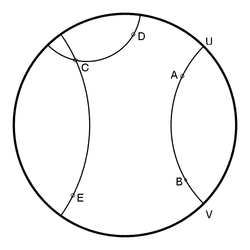 |
The figure on the
left shows the "hyperbolic straight lines" connecting the points $A$
and $B$, $C$ and $D$ and finally $C$ and $E$. The Euclidian circle arcs
$CD$ and $CE$ do not intersect the arc $AB$, which means that $CD$ and
$CE$ are parallel to $AB$.
Two straight lines are parallel if they do not intersect (or if they
coincide). In Euclidian geometry, two straight lines that are parallel
to a third line are parallel. This is clearly not the case in
hyperbolic geometry, and so our intuition is not a good guide here.
What we are also used to, is that two parallel lines are everywhere at
the same distance from each other, but in hyperbolic geometry, this is
not true either. The hyperbolic distance
$\bar{d}$ between points A and B can be defined by $$
\bar{d}=\frac{1}{2}\left|\ln{\left(\frac{AV.BU}{AU.BV}\right)}\right|$$
|
$AV, BU, AU, BV$ are the
(Euclidian!) distances between the points. If either $A$ or $B$
approach $U$ or $V$ then this distance
becomes infinitely large: the rim of the disc is not part of the
Poincaré disc, it is called the horizon "at infinity".
Where
does this formula come from?
In order to give the museum visitor the
illusion that he finds himself in a hyperbolic world, we would need to
put him/her on a disc so that the rim is invisible as it is
infinitely far away. We would also need to give visitors the
illusion that lightbeams follow paths that are circle arcs instead of
straight lines. All this is not easy! Let us first look at some other
properties of hyperbolic geometry.
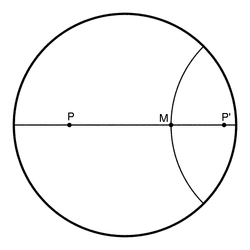 |
In the image on the
left, points $P$ and $P'$ are symmetrical
vs. the hyperbolic straight line passing through the point
$M$ and perpendicular tp $PP'$. The hyperbolic distances $\bar{MP}$ and
$\bar{MP'}$ are identical. We are of course refering to hyperbolic
symmetry, and not a Euclidian one!
One can verify, using the hyperbolic distance formula, that the point
$P'$ is obtained by inversion in the circle representing the hyperbolic
straight line passing through $M$ and perpendicular to $PP'$. If $C$ is
the center of this circle we have $$CP'=\frac{R^2}{CP}$$ |
More
about inversion.
|
In the following figure, inversion in the circle of
radius $R$ and center $C$ transforms the point $P$ in the point $P'$
such that $P$, $P'$ and $C$ are aligned and $CP.CP'=R^2$.
.This transformation is conformal: angles are preserved. In
the figure below, all the lines in the square are transformed in circle
arcs that intersect orthogonally.
Inversion transforms circles into circles (taking into account
that straight lines are circles with infinite radius).
Note that the center of a circle is not transformed in the
center of the inversion image circle.
The equivalent in three dimensions is the inversion in a
sphere. In the figure below, the point $P$ is transformed by
inversion in the sphere of radius $R$ and center $C$ to the point $P'$,
with $CP.CP'=R^2$.
Just as inversion in a circle transforms circles to circles,
inversion in a sphere transforms spheres to spheres ( but without
sending center to center).
|
Let's apply this notion of symmetry to tilings. If we
want to pave the Euclidian plane with regular
polygons, we have the choice between triangles, squares and hexagons.
With triangles, six will meet at each vertex. With squares, the number
is four, and with hexagons it is three, as in the figures below..
In our hyperbolic plane, the situation is quite
different. To start with, the sum of the angles of a triangle is not
equal to $\pi$ anymore: the sum is always smaller than $\pi$.
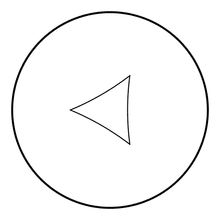 |
On
the left is an equilateral triangle where the sum of the angles is
$3\pi/4$ ( angles are measured by measuring the angles between the
tangent lines). On the right is an equilateral triangle where the sum
of the angles is close to zero.
This means that one can draw equilateral triangles with any angles
between $0$ and $\pi/3$, and that one can draw an infinity of
tesselations by equilateral triangles.
The same thing is true for the other regular polygons. |
 |
How can we draw a
tiling by regular (hyperbolic!) polygons with $n$ vertices so that
$p$ polygons meet at each vertex?
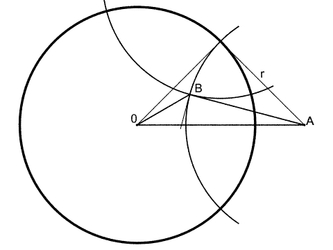 |
In
the figure on the left, we have to find the position of the center $A$
and the radius $r$ of a circle so that:
- the circle is orthogonal to the unit circle.
- The angle between this circle, and a second circle
with the same radius, rotated by an angle $2\pi/n$ around the origin,
equals $2\pi/p$.
In the triangle $ABO$, the angle $\widehat{BOA}$ equals $\pi/n$, and the
angle $\widehat{OBA}$ equals $\pi/p+\pi/2$.
As $AO=\sqrt{1+r^2}$ and $AB=r$,
we can easily find $r$ and $|OA|$. |
This construction is only possible if $\frac{\pi}{n}+\frac{\pi}{p}+\frac{\pi}{2}<\pi$, from which follows
the general rule for hyperbolic tilings: $$\frac{1}{n}+\frac{1}{p}<\frac{1}{2}$$
In order to draw the polygon, we rotate the point $A$ around
the origin by an angle $2\pi/n$, and we draw the circle arcs of radius
$r$. If we take $n=6$ and $p=4$, this gives us:
So this is a fundamental tile. As $p=4$, the angles of the
polygon are all $\pi/2$. In order to find the neighbouring tiles, all
we need to do is to draw the symmetric tiles in a hyperbolic way. The
symmetry axes are the sides of the polygon. As we have seen, symmetry
in the hyperbolic plane means inversion in a circle. The fact that the circle
inversion is a conformal transformation, assures that the
angles will be preserved, and the images by inversion (in the circles
that make up the sides of the polygons) will also have angles of
$\pi/2$. We obtain this picture:
And
we can repeat this as many times as we want:
This is the tiling that M.C.Escher used in his famous
"Cirkellimiet 4, Angels and Demons". Note that Escher
carved this in wood by hand!
M.C.Escher took this
tiling, but he obviously did not use the images of the tiles obtained
by inversion.
At each inversion, the image was turned 180° which assures that
the demons and angels match up perfectly.
Here are two other examples. On the left the same (6,4) tiling, this
time with triangles in alternating colors, and on the left a (3,18)
tiling.
Back to the science museum.
We now know how to tile the hyperbolic plane with tiles that are
obtained by circle inversions. How does this help us for our
construction in the museum?
Remember those "Galleries
of Mirrors" with all sorts of mirrors that deform the reflection of the
spectator into bizarre shapes? In order to lose some weight
all one needed to to was to stand in front of a cylindrical mirror with
a vertical axis.
So here is our idea for
the museum: We build a
chamber where the walls are cylindrical mirrors. We choose the radii
and positions of the mirrors as if we were constructing the base tile
of a hyperbolic tiling.
Here is a what such a
chamber might look like. ( At the moment, there are just two visitors,
and we still have to construct a way in and out!)
Will the visitor's view in
this chamber be exactly like the view in a real hyperbolic world?
Unfortunately, no! Let's not forget that straight lines in the
hyperbolic world, so lines that light beams will follow, are Euclidian circle
arcs. This means for instance that a visitor in one corner of the room
should be able to see all the other corners, and this is not the case!
The chamber itself is not hyperbolic..
Nevertheless, it can be
shown that the view inside the chamber, and all the reflections on the
walls do not differ much from the view in a real chamber in a
hyperbolic world. The mathematical explanation for this is outside the scope
of this article.
Let's put our camera
inside the chamber :
With good quality mirrors,
the visitors will experience the illusion that they find themselves on
an infinitely large plane, just like the inhabitants of the hyperbolic
world, who cannot see the edge
of the disc either.
For the shape of the
chamber, the possibilities are endless. Here is a chamber accoring to
the (3,100) tiling:
..and the view on the
inside:
For comparison, here is a purely Euclidian chamber:
How can we make the
experience even more spectalular for the visitors in the museum?
So far we we only talked about the hyperbolic plane, but we
can also talk about hyperbolic
space. Instead of Poincaré's disc, let's take
Poincaré's ball, the interior of a unit ball in Euclidian
space. In this ball, "hyperbolic planes" are pieces of spheres that are
orthogonal to the unit sphere. Symmetries can now be described by
inversions in these spheres.
This hyperbolic space can also be "tiled" by regular
polyhedra. In our Euclidian world, the only regular polyhedron capable
of such a tiling is the cube, but in the hyperbolic world we
have a choice! We will see that the choice is not as abundant as what
we could in the hyperbolic plane. Note that the hyperbolic space that
we are refering to is three-dimensional. One can also discuss higher
dimensional hyperbolic spaces, and the possibilities to tile that
space, but this would lead us too far ( more specifically, outside of
the competence of this author!). Suffice it to say that it has been
shown relatively recently that such a tiling is impossible in
dimensions higher than 30, a theorem dating from 1983 by the Russian
mathematician Ernest Vinberg.
Hyperbolic regular polyhedra are objects with faces that are
pieces of spheres.
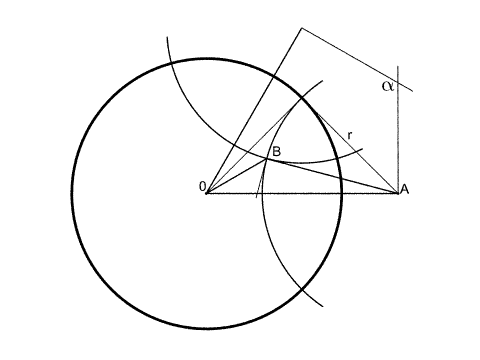 |
Look at the figure
on the left: this can be considered as a cut through the
Poincaré ball by a plane passing through the origin.
The angle $\widehat{BOA}$ is now equal to $(\pi-\alpha)/2$, with
$\alpha$
the diedral angle of the Euclidian polyhedron. In order to be able to
construct tilings where $p$ polyhedra meet at each edge, the condition
is : $$\frac{\pi}{p}<\frac{\alpha}{2}$$
There is also a second condition: the spheres that make up
the faces of the polyhedron must be orthogonal to the unit sphere,
which creates a maximum for $p$: for polyhedra where three faces meet
at a vertex, the maximum value of $p$ is 6, for 4 faces this is 4, and
for 5 faces it is 3.333..
|
All this limits the possibilities for tilings by hyperbolic
regular polyhedra to the following:
- Tetrahedron with dihedral angles of
60° with
"vertices" on the unit sphere ( a purist opnion could be that this is
not really a polyhedron as the vertices are at infinity, and the
inhabitants of the hyperbolic balls cannot see them!)
- Cube with dihedral angles 72° or 60°. In
the latter case, the "vertices" are at infinity.
- Octahedron with dihedral angles 90°.
- Dodecahedron with dihedral angles 90°,
72°
or 60° ( in the latter case the "vertices" are at infinity).
- Icosahedron with dihedral angles 120°.
For our museum, we could
consider a chamber with spherical
walls,
arranged to obtain a tiling of hyperbolic space. here is a chamber in
the shape of a hyperbolic cube:
Here is a view inside the chamber. Click here for a 360°
panoramic view.
If you prefer a chamber in the shape of a dodecahedron:
..the view inside the chamber is this:
And finally an icosahedron project:
All that is left now is to convince a museum director to invest in such a project!
More information on the subject :
1. Non-Euclidian geometry.
2. The Poincaré disc.
3. "Curved spaces" by Jeff
Weeks.
4. Hyperbolic tilings.
|



